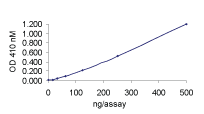
PTPN13 (FAP-1), Active(P40-21G)
FOR BULK ORDER REQUESTS PLEASE CONTACT US
Description :Recombinant human PTPN13 (2169-2485) was expressed in E.coli cells using a N-terminal GST tag.
Species :Human
Tag :GST tag
Expression System:E.coli
Sequence :2169-2485
Genbank Number :NM_080683
Specific Activity :Sample Enzyme Activity Plot. For specific information on a given lot, see related technical data sheet.
Purity :Sample Purity Data. For specific information on a given lot, see related technical data sheet. 
Storage, Stability and Shipping :Store product at –70oC. For optimal storage, aliquot target into smaller quantities after centrifugation and store at recommended temperature. For most favorable performance, avoid repeated handling and multiple freeze/thaw cycles.
Applications :Phosphatase Assay, Western Blot
Molecular Weight :~61 kDa
Gene Aliases :PTP-BAS, PNP1, FAP-1, PTP1E, PTPL1, PTPLE, PTP-BL, DKFZp686J1497
Scientific Background :PTPs are known to be signaling molecules that regulate a variety of cellular processes including cell growth, differentiation, mitotic cycle, and oncogenic transformation. PTPN13 is a large protein that possesses a PTP domain at C-terminus, and multiple noncatalytic domains, which include a domain with similarity to band 4.1 superfamily of cytoskeletal-associated proteins, a region consisting of five PDZ domains, and a leucine zipper motif (1). PTPN13 binds to a negative regulatory domain in Fas that inhibits Fas-induced apoptosis (2).
References :
1. Saras, J. et al: Cloning and characterization of PTPL1, a protein tyrosine phosphatase with similarities to cytoskeletal-associated proteins. J. Biol. Chem. 269: 24082-24089, 1994.
2. Inazawa, J. et al: PTPN13, a Fas-associated protein tyrosine phosphatase, is located on the long arm of chromosome 4 at band q21.3. Genomics 31: 240-242, 1996.
Product Sheets (By Lot #) :
Research Areas :Cancer, Invasion/Metastasis, Phosphatases, Cancer, Inflammation, Metabolic Disorder, JAK/STAT Pathway, WNT Signaling, Invasion/Metastasis, Phosphatases
